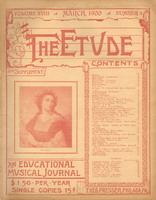Our correspondent who wishes to be advised on the question of supplementary work in connection with “Henning’s Method” has made a request not easily complied with except on the broadest possible basis of suggestion. “Henning’s Method,” like many works of similar character and purpose, is merely an instructive book to be utilized as a guide and a help to the beginner. It can hardly be considered as aiming at anything higher than a mere initiation into the early mysteries of violin-playing. Like all other methods, it calls for no special supplementary studies, the question of logical progression depending entirely upon the degree of proficiency attained through the study of the method itself. Then, too, the conscientious teacher will always take into consideration the pupil’s talent and temperament, if, indeed, unmistakable indications of such qualities have manifested themselves at so early a period of his studies.
Brief, melodious etudes and pieces should naturally follow the study of any method. Of the former, Fr. Hermann’s “One Hundred Etudes” and Hans Sitt’s studies in the first position can heartily be recommended for the majority of students. Among the easy and (for pedagogical purposes) admirably written pieces in the lower positions, I would mention the original pieces by Charles Dancla, published in “Suites”; the “Bluettes,” by Leopold Dancla; the easy pieces by Hans Sitt; Gustave Hollaender’s opus 48; de Beriot’s “Italian Melodies,” etc.



